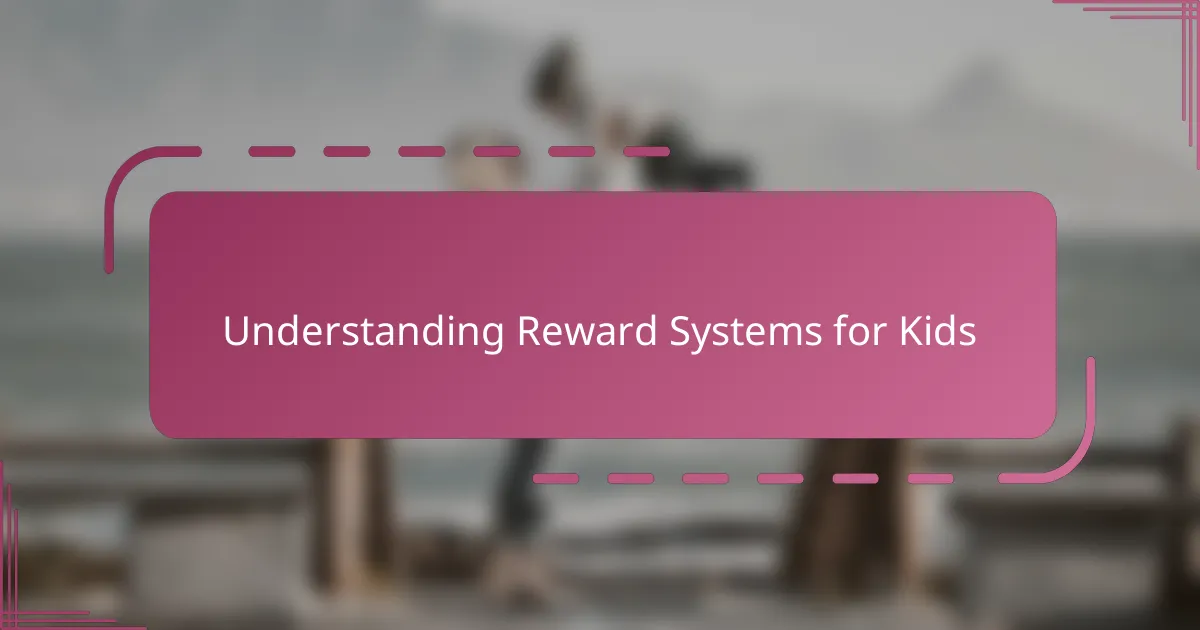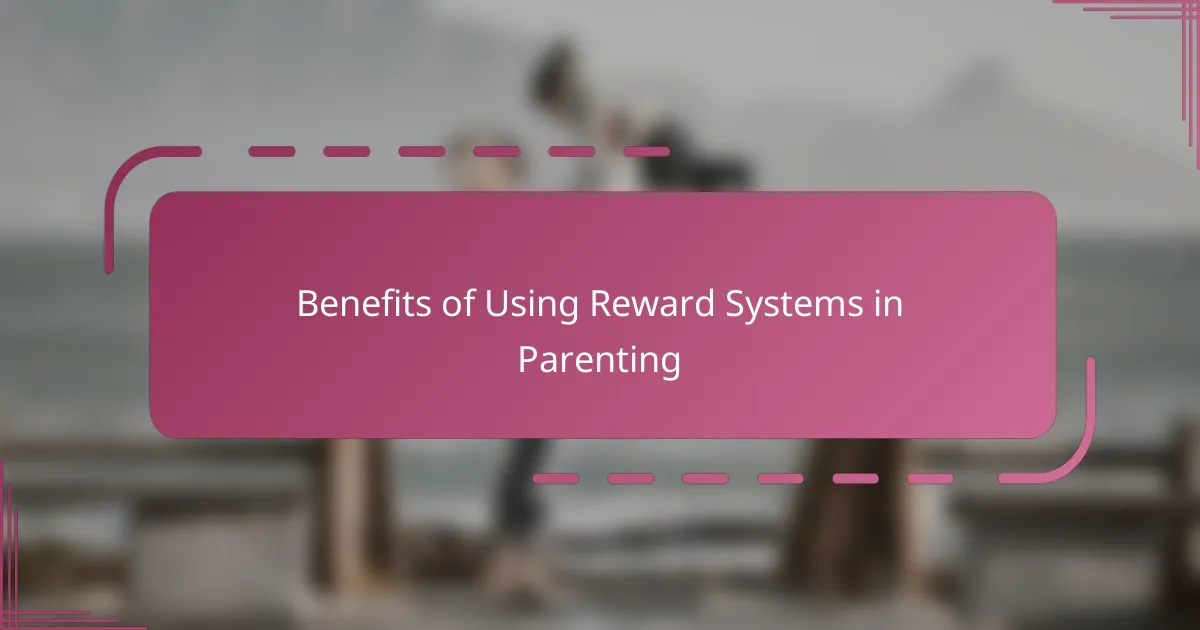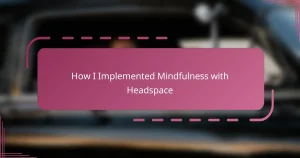Key takeaways
- Effective reward systems for kids encourage positive habits and boost motivation through immediate and clear feedback.
- ChoreMonster app gamifies chores, making them engaging and allowing children to visualize their accomplishments and rewards.
- Customization of chores and rewards according to children’s interests enhances involvement and motivation.
- Flexibility in adjusting tasks and rewards based on progress helps maintain enthusiasm and prevent boredom.

Understanding Reward Systems for Kids
Reward systems for kids are more than just about giving treats or prizes—they are about encouraging positive habits and making children feel valued. I’ve noticed that when my child sees a clear connection between effort and reward, their motivation soars naturally. Have you ever wondered why simple praise sometimes feels more powerful than tangible rewards?
In my experience, the best reward systems balance consistency with flexibility. Kids thrive on routine but also need to feel that their individual efforts are recognized in a meaningful way. This approach fosters not only good behavior but also builds confidence and a sense of responsibility.
When I first tried setting up a reward system, I quickly realized that rewards lose their magic if they’re too vague or far off in the future. Kids, especially younger ones, need immediate and understandable feedback. That’s why structuring the system to provide clear milestones made all the difference in keeping my child engaged and excited about completing chores.

Benefits of Using Reward Systems in Parenting
One of the biggest benefits I’ve seen from using reward systems is how they turn everyday tasks into opportunities for learning. When my child knows that finishing a chore means earning points or a treat, it transforms the experience from a nagged obligation into a personal goal. Have you noticed how children seem more willing to pitch in when they can visualize the payoff?
I also find that reward systems build a strong sense of achievement. It’s not just about the prize itself, but the pride that comes with earning it. Watching my child’s face light up after hitting a milestone made me realize that these systems help nurture self-confidence in ways simple commands never could.
Lastly, using a structured reward system has helped me stay patient too. Instead of repeating reminders over and over, I could rely on the system to guide behavior consistently. It made our daily routines smoother and created a quiet rhythm of positive reinforcement that felt natural rather than forced. Doesn’t it feel good when discipline becomes encouragement?

Introduction to ChoreMonster App
ChoreMonster is an app designed to make chores fun and rewarding for kids, turning routine tasks into an engaging game. When I first introduced it to my child, I was curious if technology could really motivate them without feeling like a constant reminder or nag. To my surprise, the colorful animations and earned points made chores feel less like work and more like a challenge to conquer.
What I especially appreciate about ChoreMonster is how it blends accountability with excitement. The app lets kids track their progress and immediately see the rewards they’ve unlocked, which keeps motivation alive in a way that generic praise often can’t. Have you ever seen a child’s eyes light up over something as simple as earning a virtual monster or badge? That’s exactly the moment when effort meets delight.
Another thing that caught my attention is how easy it is for parents to customize chores and rewards to fit their family’s unique needs. From my perspective, this flexibility means the system evolves with your child, making each achievement feel personal and meaningful. It’s not just a tool; it’s a way to build habits that stick.

Setting Up a ChoreMonster Account
Setting up a ChoreMonster account was surprisingly straightforward, which really helped me get started without feeling overwhelmed. I remember sitting down with my child, and together we created individual profiles—this simple step made them feel involved and in control from the very beginning. Have you ever noticed how kids respond better when they have a say in the process?
Once the profiles were set up, I took some time to customize chores and rewards to match our daily routines and my child’s interests. This part felt crucial because generic tasks wouldn’t have sparked the same excitement. I found that tailoring chores, like “putting away toys” or “helping with dishes,” to our lifestyle made the app meaningful rather than just another checklist.
One feature I appreciated was how easy it was to adjust settings as we went along. If a chore seemed too hard or too easy, I could tweak it quickly without starting from scratch. This flexibility kept the system feeling fresh and fair, which kept my child eager to keep earning points and unlocking fun rewards. Have you tried something that lets you adapt on the fly? It really makes all the difference.

Designing Effective Rewards with ChoreMonster
Designing rewards in ChoreMonster isn’t just about piling up points; it’s about choosing incentives that truly resonate with your child. I learned early on that the most effective rewards matched my child’s interests—whether it was extra screen time or a special outing. Have you noticed how a reward feels more magical when it’s something your child actually looks forward to?
What I’ve found especially helpful is setting up a mix of short-term and long-term rewards. Seeing immediate wins kept my child motivated daily, while the promise of bigger rewards encouraged consistent effort over time. This balance helped prevent boredom and kept the system from feeling like a chore itself.
ChoreMonster’s customization options made tailoring rewards straightforward, turning abstract goals into clear, achievable milestones. I loved how my child could visualize progress and celebrate little victories along the way. Isn’t it amazing how acknowledging small successes builds momentum for bigger achievements?
![]()
Tracking Progress and Adjusting Rewards
Tracking progress with ChoreMonster quickly became one of my favorite parts of the system. I could see exactly which chores my child completed and how many points they earned, which made the whole process transparent and motivating. Have you ever tried a system where the progress just feels invisible? That disconnect can kill motivation fast, but this app solved that problem beautifully.
Adjusting rewards was surprisingly intuitive as well. When I noticed my child breezing through certain chores without much effort, I upped the stakes a bit—either by increasing points or introducing more exciting rewards. It felt like tuning a dial to keep them challenged but not discouraged. Don’t you think that’s the tricky balance every parent hopes to find?
Sometimes, we also scaled back rewards if progress slowed, using that as a gentle cue to refocus attention. What struck me most was how flexible this approach allowed me to be without confusing my child. It turned our routine into an ongoing conversation about effort and achievement, rather than a rigid system that either frustrated or bored us both.

Personal Experience and Tips for Success
One thing I quickly learned is that patience truly pays off when using ChoreMonster. At first, my child was skeptical, but after a few days of consistent tracking and celebrating small wins, their enthusiasm grew noticeably. Have you ever noticed how a little encouragement at the right moment can turn reluctance into excitement? That’s exactly what happened in our home.
I also discovered that involving my child in updating the chores and rewards kept the system alive and relevant. When they suggested swapping out a reward or adding a new task, it gave them a sense of ownership that, in my opinion, made all the difference. Don’t you find that when kids feel heard, they’re naturally more motivated to participate?
Lastly, I found that flexibility was key to long-term success. Life isn’t always predictable, and being able to adjust points or rewards on the fly helped keep things fair and fun. I can’t stress enough how important it is to watch the process closely and tweak as needed—this kept the experience positive for both of us, transforming chore time into something we both looked forward to.


